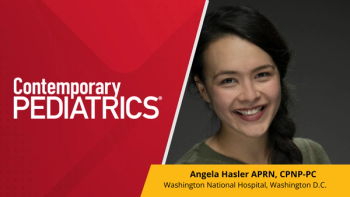
Full recap from the 2025 Pediatric Academic Societies meeting
In this article, we recap our top stories, expert interviews, and Q+A discussions from the 2025 Pediatric Academic Societies meeting.
The
Contemporary Pediatrics covered several sessions, poster sessions, and oral abstracts from the meeting, and interviewed multiple presenting authors and experts across a myriad of subject matter.
Below, we recap our complete coverage from the meeting, with direct links to our full articles, video interviews, and Q+A discussions with presenting authors.
Thank you for filling out some brief information to access this article, and for reading Contemporary Pediatrics.
Interested in receiving more news directly from us? Consider subscribing to our
Articles
Antibiotic use before age 2 linked to higher childhood BMI
Researchers from the University of Oulu reported that children exposed to antibiotics during their first 2 years of life had a significantly higher risk of becoming overweight or obese later in childhood. In a study of over 33,000 vaginally born children, early antibiotic use was associated with higher BMI-for-age z-scores at age 2 and a 20% increased risk of obesity by age 12. No associations were found for antibiotic exposure before or during pregnancy. With 68% of children in the study receiving antibiotics in early life, the authors emphasized cautious prescribing practices, particularly for upper respiratory tract infections, to mitigate long-term health risks like obesity.
Pegtarazimod data confirms inflammation biomarkers in hypoxic ischemic encephalopathy infants
On April 25, 2025, ReAlta Life Sciences shared new biomarker and pharmacokinetic data supporting the potential of pegtarazimod (RLS-0071) for treating moderate-to-severe hypoxic ischemic encephalopathy (HIE) in newborns. Inflammatory biomarkers from the STAR trial showed significantly elevated levels of MPO, cell-free DNA, and neutrophil elastase in affected infants, confirming MPO pathway activation previously observed only in animal models. Pharmacokinetic results from 10 neonates dosed with pegtarazimod demonstrated predictable, bi-exponential drug behavior, no accumulation, and target concentrations consistent with efficacy seen in preclinical studies. Findings support further development of pegtarazimod as an adjunct to therapeutic hypothermia in neonatal HIE.
“The data being presented at PAS advance both our understanding of the disease and the strong potential of pegtarazimod in treating newborns with HIE,” said Paolo Martini, PhD, chief research & development officer at ReAlta in a statement. “We are encouraged by the consistency of the pharmacokinetics and the emerging biomarker data."
Uncovering the pediatrician's role in OTC STI testing, with Lea Widdice, MD
In this Q&A with Lea Widdice, MD, director of the Adolescent Medicine Fellowship and associate professor at the University of Cincinnati Department of Pediatrics in Cincinnati, Ohio, she breaks down her presentation and the importance of accessibility to over-the-counter STI tests. View a sample question and answer below, and click the link for the full interview.
Contemporary Pediatrics:
As over-the-counter STI tests become more accessible, how do you see the pediatrician’s role evolving in terms of adolescent sexual health education and counseling?
Lea Widdice, MD:
Pediatricians will continue to be a source of positive sexual health education and counselling to patients and parents as over-the-counter STI tests become available. Pediatricians can be a source of information about the signs and symptoms of STIs, as well as the American Academy of Pediatrics’ recommendations for screening for STIs and prevention of STIs.
Youth with neurodevelopmental disabilities face higher risk of poor cardiovascular health
Youth with neurodevelopmental disabilities (NDD) are significantly more likely to experience poor cardiovascular health (CVH) compared to their peers without NDD, based on analysis of the 2021 National Survey of Children’s Health. Using a modified Life’s Essential 8 scoring system, the study found lower rates of healthy sleep, lower diabetes and obesity metrics, and reduced overall CVH scores in youth with NDD. These children also had nearly double the odds of having a heart condition and a 53% higher likelihood of poor CVH overall. Findings highlight the need for targeted cardiovascular interventions in pediatric populations with NDD.
Parents more likely to ask about guns in homes when they receive firearm safety information
Parents are significantly more likely to ask about firearms in other homes when they are exposed to gun safety messages from multiple sources. In a national survey of nearly 1,600 caregivers, those who received firearm safety information from 8 different sources were nearly 5 times more likely to inquire about unsecured guns (79% vs 16%). Each additional source increased the likelihood by 40%. Despite national guidelines, fewer than 9% of caregivers recalled discussing firearm safety with a healthcare provider, highlighting a missed opportunity in clinical practice. Findings support a multifaceted, community-wide approach to firearm safety education.
“Our findings suggest that exposure to firearm safety messaging from multiple sources can significantly influence caregiver behavior,” said Maya Haasz, MD, associate professor at Children’s Hospital Colorado and the presenting author of the study. “Robust firearm education for parents builds a safer future for children where conversations about gun safety among parents and in communities are the norm rather than the exception.”
Buprenorphine linked to improved outcomes for pregnant women with OUD and their infants
Pregnant women with opioid use disorder (OUD) who received buprenorphine had significantly improved outcomes for themselves and their newborns. In a study of over 14,000 women enrolled in Tennessee Medicaid, buprenorphine treatment was associated with a 37% reduced risk of preterm birth, 20% lower risk of maternal morbidity, and 22% lower risk of neonatal ICU admission. Despite its benefits, buprenorphine remains underutilized, and access disparities persist—particularly for Black patients. Authors urged expanded, equitable access to treatment to reduce preventable maternal and infant complications.
“Disparities in access to buprenorphine significantly affect vulnerable populations, including pregnant women,” said Sunaya Krishnapura, a graduating medical student at Vanderbilt University School of Medicine and the study’s presenting author. “Our findings underscore the urgent need for policies that expand treatment access in the United States to ensure a healthy pregnancy and future for mothers and infants.”
Video interviews
Decreasing antibiotics for acute otitis media and community acquired pneumonia, with Elysha Pifko, MD
Elysha Pifko, MD, shared results from a large-scale quality improvement initiative that significantly reduced antibiotic duration for acute otitis media (AOM) and community-acquired pneumonia (CAP) without compromising clinical outcomes. Implemented across 72 sites, the project increased adherence to recommended treatment durations from 51% to 83% over 1 year, supported by education, standardized order sets, and monthly feedback. Shorter courses proved effective, with no increase in repeat prescriptions, reinforcing national guidelines for judicious antibiotic use in pediatric care.
Validating a digital stethoscope for pediatric breath sounds, with Jennifer Nestor, MD
On April 26, 2025, Jennifer Nestor, MD, presented findings from a study validating digital stethoscope use to record pediatric breath sounds, with implications for both bedside care and future machine learning applications. Conducted during a national albuterol shortage, the study showed moderate interrater agreement (k = 0.43) between bedside clinicians and blinded experts, highlighting both the promise and current limitations of the technology. Despite fair-to-moderate reliability, the findings support its potential in aiding clinical decisions and building a pediatric breath sound database.
“There is no gold standard [for pulmonary auscultation],” Nestor said. “The gold standard is the trained professional who’s listening to the patient at the bedside and hearing specific things.”
Youth cannabis use and depression, suicidal behavior, with Jesse Hinckley, MD, PhD
In this Contemporary Pediatrics video interview, Jesse Hinckley, MD, PhD, discussed findings from a national survey that linked adolescent cannabis use to significantly increased odds of major depressive disorder and suicide attempts. Even infrequent use was associated with elevated risk, while more frequent use showed a clear dose-response relationship.
“When we looked at lifetime suicide attempt after accounting for whether or not they had a major depressive disorder, those who had used cannabis in their lifetime were 6.9 times more likely to have attempted suicide,” Hinckley said. He emphasized the need for pediatric providers to screen for cannabis use and recommended motivational interviewing to effectively engage teens on this growing mental health concern.
Jillian Cotter, MD, MSCS, on recent advances in pediatric pneumonia management
Jillian Cotter, MD, MSCS, discussed emerging research supporting shorter antibiotic courses—specifically 5 days—for children with pneumonia, citing data showing similar clinical outcomes and fewer adverse events compared to longer regimens.
“They see kids reach their clinical response similar times…with fewer days of antibiotic therapy,” Cotter explained. She noted that her hospital has successfully implemented 5-day courses even for inpatient cases. Cotter also addressed ongoing diagnostic challenges and emphasized the importance of antibiotic stewardship through narrow-spectrum choices, shorter duration, and oral over IV routes to improve outcomes and reduce unnecessary exposure.
Necessity for iron deficiency screenings at birth with Geetika Kennady, MD, FAAP
Geetika Kennady, MD, FAAP, presented findings from a prospective study showing that over 10% of newborns—regardless of risk status—were iron deficient at birth, challenging the long-held assumption that fetal iron transfer is always sufficient. “With these high prevalence rates, we should be prioritizing early screening and identification of iron deficiency at birth,” Kennady said. She emphasized that early detection is critical due to the link between iron deficiency and long-term neurodevelopmental impairment, and advocated for low-cost, widely available iron supplementation as a safe intervention.
Zika-based therapy for metastatic neuroblastoma with Tamarah Westmoreland, MD and Joseph Mazar, PhD
Joseph Mazar, PhD, and Tamarah Westmoreland, MD, FAAP, shared promising preclinical findings on the use of Zika virus to treat metastatic high-risk neuroblastoma, a pediatric cancer with a 5-year survival rate of just 40% to 50%. By injecting Zika directly into 1 tumor in mouse models, the virus replicated and eliminated tumors throughout the body. “You're effectively weaponizing 1 tumor to kill the others,” Mazar explained. The team emphasized Zika’s low inflammatory profile and its potential as a safe, innovative option for cases where traditional therapies fall short.
Newsletter
Access practical, evidence-based guidance to support better care for our youngest patients. Join our email list for the latest clinical updates.








